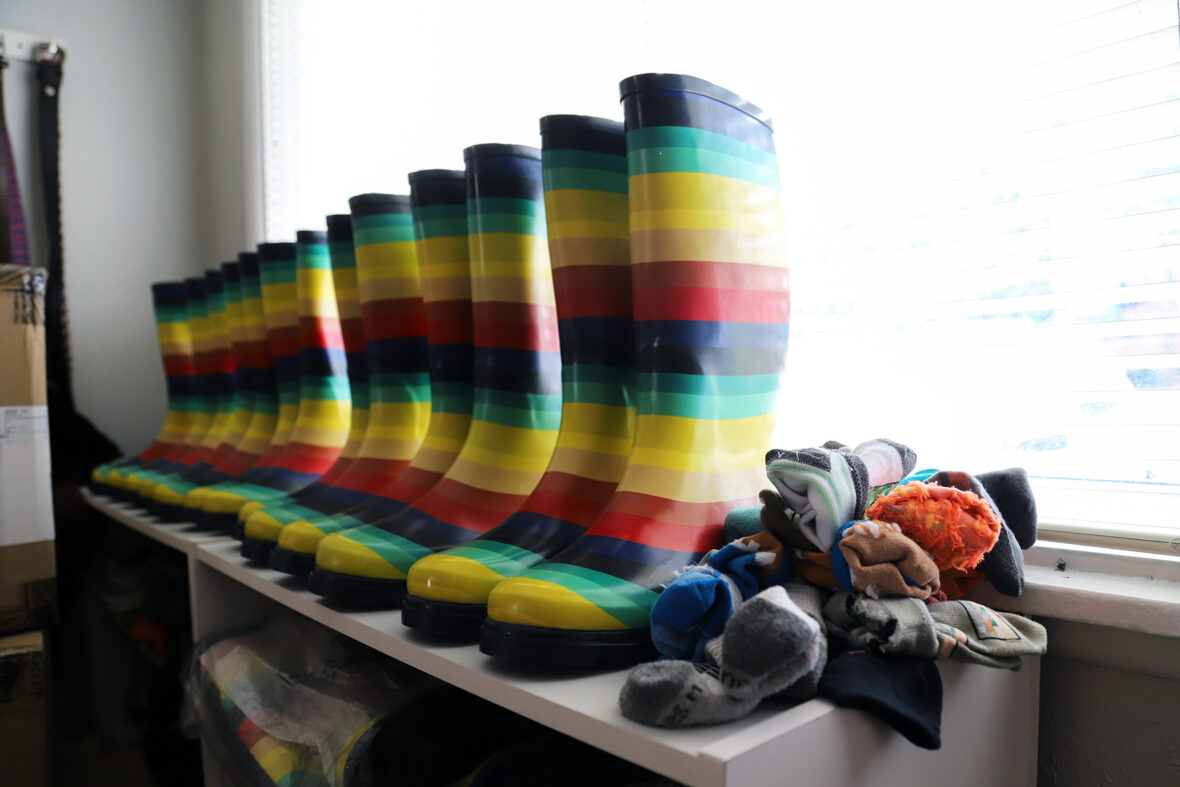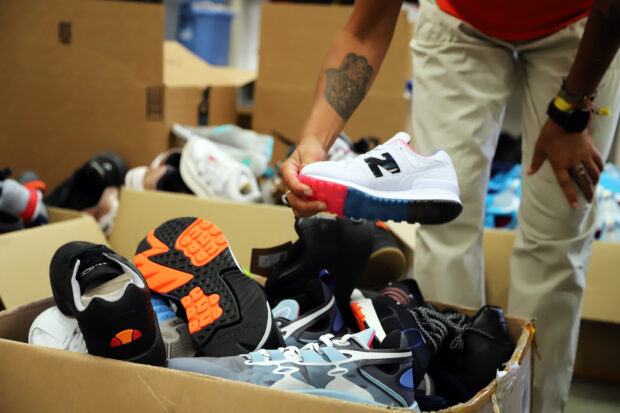This is the second story in a three-part series about how Idaho’s homeless children and families faced unique challenges in the past two years. This series spotlights how Idaho educators are making extraordinary efforts to meet their needs. Read the first story, here.
Editor’s note: The names Angela and Miranda are pseudonyms. Idaho Education News agreed to withhold these sources’ names in order to protect their privacy.
Angela stared at her daughter’s enrollment form for the Nampa School District, dread settling in the pit of her stomach.
The form asked for an address. They didn’t have one. Angela, her high school daughter, and adult son with autism had been living in relatives’ spare rooms and their vehicle since Angela’s partner left, and the family could no longer afford their house.
She considered writing a random address, to hide the family’s situation from the district.
“I pitied myself. What kind of a parent am I to let my family and I be in that situation?” Angela told EdNews. “It was sadness, despair, it was every horrible emotion you could think of.”
But Angela was out of options — she’d already been to family and friends for help, and connected with local shelters. She decided to be honest with the district, to tell them she and her kids didn’t have an address. The district, she says, became a lifeline.
“Just when I thought there was no light at the end of the tunnel, I’d get a phone call from her,” Angela said of district homeless education coordinator Natalie Sandoval. “It was like a gasp of relief, a gasp of fresh air.”
Almost immediately, Nampa’s homeless education liaisons got Angela and her children connected to food and hygiene products. The district paid for a brief hotel stay, a much-needed respite for the family sleeping in a truck. After months of calling rentals, Angela’s family landed an apartment.
Idaho’s housing crunch is forcing families into homelessness for the first time, and state officials think some are hesitant to ask their school districts for help. Families might not realize the school can do much more than connect them to free lunch, state homeless education coordinator Suzanne Peck said.
At first, Angela’s 17-year-old daughter, Miranda, was embarrassed that the district knew about her situation. She’d spent the first few months of the 2020 pandemic hiding the camera during her Zoom classes, trying to keep classmates from guessing she lived in her car.
“I realized that my mom never reached out for help like that unless she really needs it,” Miranda said. “It made me feel good realizing that she trusts these people and that we had someone to go to.”

School districts offer everything from clothes to community pantries
In early July, when most Nampa employees were on summer vacation, Sandoval sat in the district’s homeless outreach office, fielding calls from families in crisis.
Sandoval started this particular Tuesday with a plan. It’s out the window by 8:30 a.m., when Sandoval gets a call from a woman who took custody of her six grandkids from parents with a history of substance abuse who are in and out of jail.
A community church was helping the family with food, but could Sandoval get them pull-ups, and an application for reduced-price child care?
Sandoval says she’ll throw in a gift card for the grandmother’s morning coffee, too.
“Everybody deserves a little bit of a break,” she says.
Sandoval finds the child care application in between Zoom meetings and phone calls. On her way to a local homeless shelter, to share an excess of socks donated to the district, Sandoval calls the kids’ school counselor to update her on the situation. Then it’s a trip to one of the district’s community resource centers to pick up snacks and sippy cups to drop off at the kids’ new home.
“Our families’ lives are for the most part day-to-day,” Sandoval said. “I can’t tell (them), you’re not on my schedule today. As a social worker, you have to be adaptable to the people that you serve.”
By the time she’s back at her office mid-afternoon, Sandoval’s printer is starting to stack up with referrals for potentially homeless families flagged by the district enrollment system. Today she’s got about 20. Closer to the school year, she expects 50 to 60 a day. Sandoval’s team will call each family to determine who needs their services.

The Nampa School District serves one of the highest populations of homeless youth in the state. Most years, Sandoval’s team helps more than 1,000 youth, up to age 21.
Statewide, Idaho educators reported about 7,300 homeless students enrolled in K-12 schools last year. Experts assume that’s an undercount.
Every district is required to have a liaison for homeless children and youth, under a federal law called the McKinney-Vento Act. In some districts that’s a full-time gig. In others, it might be one of many hats worn by a superintendent or administrator. These liaisons’ primary job is to make sure that homeless youth are enrolled in school and can succeed academically.
“Homeless,” is a flexible term where education is concerned. Kids qualify if they are sharing housing with another person because of financial hardship, or living in motels, shelters, cars or campgrounds because they have nowhere else to go.
School districts have to ensure these kids have access to “free, appropriate public education” under federal law. Districts have to immediately enroll homeless students, even if they’ve missed registration deadlines or don’t have all of the necessary paperwork. Families also have a right to transportation to their kids’ established school, even if a family moves off a bus route or out of district because they lose housing.
Liaisons can also pay for gas money for students who need help getting to school, help families with toiletries and clothing and food, pay for extracurricular costs and medical expenses like glasses and dentistry.
“The real purpose of the program is to remove barriers so kids can succeed,” Peck said.
Sandoval’s office, a house donated to the Nampa district, is lined wall to wall with supplies. Rainbow-striped rain boots stand sentinel next to a window, and children’s belts hang from hooks on the wall. Rooms are littered with boxes of new shoes and socks, and backpacks donated by corporations and biker clubs. The district has a washer and dryer for families that need to do their laundry, and air mattresses for kids who are sleeping on someone else’s floor.
There is one resource that McKinney-Vento coordinators can’t pull out of their pockets: Housing.
Sandoval can help families connect with shelters, apply for government vouchers and get in touch with nonprofits that help families find homes. But with years-long waiting lists for affordable housing, and a lack of low-income options around the state, Sandoval can’t guarantee families that they will find a place. She doesn’t want to give them false hope.
“I’m a very positive person, but I’m also a realist,” she tells families. “This is probably going to be your reality for a good amount of time.”
The housing situation is prompting frank conversations with teachers, too: What can they do to accommodate students who might be in challenging situations for an extended period of time?
Christina Fullmer, a McKinney-Vento coordinator in Idaho Falls, asks educators to take students’ living situations into account when they are assigning work, and perhaps consider reducing homework to what a student can accomplish at school.
Students living in their car, or moving from place to place, might be in “survival mode,” she said.
“Getting academic work done at home can be an added stress,” in those situations, Fullmer said. “And not very effective.”

Coordinators pick up the role of helping people stay housed
Sandoval walks through homelessness with Nampa’s families, helping them navigate housing instability, and giving them resources to lighten the load.
As she crisscrossed the district on that summer Tuesday, Sandoval called Angela, whose family she’d helped the summer before.
Finding an apartment was a six-month struggle for Angela, who earns $714 a month in Social Security, in a town where the median rents are almost double that. Angela would come into Sandoval’s office with notebooks keeping track of the apartments she’d applied for, and her place on the waiting lists.
“You were working harder than most people at a full-time job,” Sandoval remembers, on her call with Angela. “That was your day, every day, was surviving, looking, planning.”
Three days before the start of Miranda’s junior year, Angela got the call: They were at the top of the list for a small, three-bedroom apartment. Between Angela’s Social Security, and part of her son’s disability check, the family could afford the $910 rent.
When Nampa started the 2020-21 school year virtually, Miranda logged into class from her own bedroom, instead of the cab of a truck.
“I didn’t have to hide anything anymore,” Miranda said. “I had somewhere to be.”
Almost a year later, Angela came back to Sandoval for help. She was having trouble making her monthly bills. Miranda sometimes had to pitch in money from her after-school job, and when things got really tight, Angela would resell household goods she picked up for free through Facebook.
Though they didn’t technically qualify for McKinney-Vento services anymore, Sandoval said she’d try to help the family connect with rental-assistance, through a group like the Idaho Housing and Finance Association. Sandoval and Angela sat down to fill out an application, together.
“We want to do everything we can so you don’t enter back into homelessness,” Sandoval said.
Do you need to connect with the McKinney-Vento liaison in your school district, to access their services, or donate supplies for youth? Find a full list of coordinators in every district, here.
